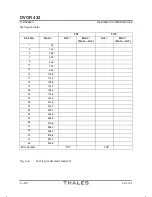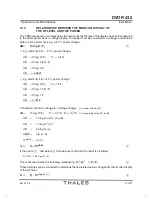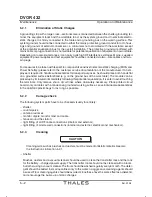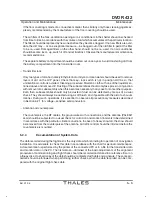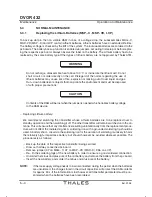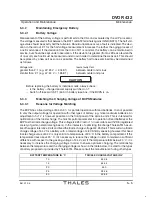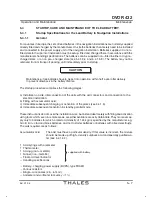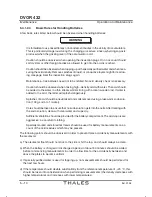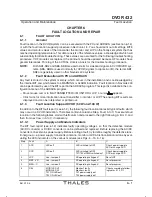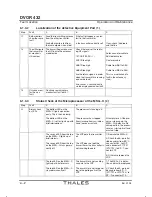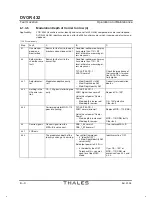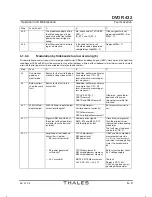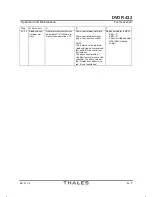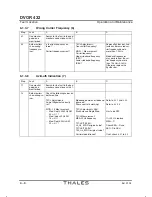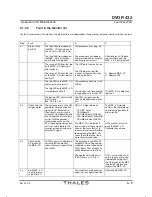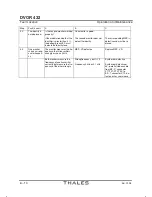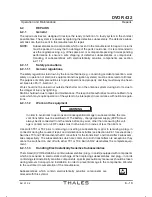
DVOR 432
Maintenance
Operation and Maintenance
5-12
Ed. 01.04
5.4.1.3.4
Initial Charging
WARNING
There is a particular risk during the charging procedure, since oxyhydrogen gas develops
in the gassing level of the battery acid is reached. It is therefore forbidden to use naked
flames or incandescent bodies in the vicinity of accumulators. Sufficient ventilation should
be provided for the battery compartment. The acid vapors are aggressive, therefore care
should be taken of clothing.
The battery manufacturers specify various methods with settings and nominal data. The appropriate
instructions are contained in the handling specifications accompanying with each battery. A constant
current charge (I-characteristic) is used for the battery charged power supply in the navigation instalĆ
lation. Two test shunts, which generate a voltage drop of 2 mV/A, are installed in the BCPS. Current
measurements can thus be performed via the software.
The acid density and temperature must be measured and noted once an hour during the charging
procedure at every 6th or 3rd cell (test cells). The same applies to the battery voltage, which should
be measured at the battery poles. For voltage measurements see Chapter 5.4.1.1).The duration of
the charging procedure depends on the state of the plates, and should be at least 6 hours.The crucial
factor for determining the end of the charging procedure is that the battery voltage and the acid densiĆ
ty no longer rise over a test interval of 2 hours, and that the nominal values have been reached.If the
acid density and the battery voltage do not reach their nominalvalues despite absolute conformance
with the charging specifications, the charging procedure must be continued with the same charging
data for a further 10 hours. If the acid density still does not reach its nominal value, the acid density
must be adjusted. If the density is too low, higher-density acid (mixed acid) must be added. If the
acid density is too high, specially purified water must be used for topping up. The temperature and
acid level must be taken into consideration when measuring the density, in other words the nominal
acid density is valid when the acid level indicator is at max.
If water is lost during the charging procedure on account of gassing, the acid must be topped up with
specially purified water. If it is necessary to correct the acid density or acid level, the battery must be
topped up beforehand with specially purified water. If it is necessary to correct the acid density or acid
level, the battery must be charged again with the same charging values for approx. 1 hour in order
to make sure the acid is properly mixed. This is ensured by means of the gassing which results.The
acid temperature must be monitored during the charging procedure. This is particularly important in
case of high ambient temperatures. The acid temperature may not exceed 55 °C. If a temperature
of 50 °C is reached, a cooling period should be allowed until the temperature has dropped to 35 °C
again.
The battery is ready for service when the nominal values have been reached and each cell has the
correct acid level (max. marking of acid level indicator). Finally the outside of the battery should be
cleaned with water to remove acid and dirt. The battery should then be installed immediately in the
navigation installation, and operated in standby parallel mode. This procedure ensures that the batĆ
tery is always charged, but that it is not operated close to the gassing level. The charge characteristic
of the BCPS (current/voltage characteristic or I-U characteristic) ensures that the limit values speciĆ
fied by the battery manufacturer are conformed with, including subsequently charging and dischargĆ
ing operation. No further measures are necessary.
NOTE:
Each battery cell/battery must have the same charge or discharge state on account of the
series connection.
The following table summarizes the procedure.
Содержание DVOR 432
Страница 2: ......
Страница 4: ......
Страница 16: ...DVOR 432 Table of Contents Operation and Maintenance X Ed 01 04 ...
Страница 38: ...DVOR 432 General Information Operation and Maintenance 1 6 Ed 01 04 ...
Страница 40: ...DVOR 432 General Information Operation and Maintenance 1 8 Ed 01 04 ...
Страница 46: ......
Страница 66: ...DVOR 432 Installation Operation and Maintenance 2 24 Ed 01 04 ...
Страница 74: ......
Страница 136: ...DVOR 432 Installation Operation and Maintenance 4 32 Ed 01 04 ...
Страница 172: ...DVOR 432 Repairs Operation and Maintenance 6 22 Ed 01 04 ...
Страница 186: ...DVOR 432 Repairs Operation and Maintenance 6 36 Ed 01 04 ...
Страница 192: ...DVOR 432 Installation Operation and Maintenance Annex Nextfield AN 4 Ed 01 04 ...
Страница 194: ......
Страница 195: ...DVOR 432 Operation and Maintenance Annex Nextfield L 1 Ed 01 04 CHAPTER 2 CHAPTER 3 For Chapter numbering only ...
Страница 196: ...DVOR 432 General Operation and Maintenance Annex Nextfield L 2 Ed 01 04 ...
Страница 204: ...DVOR 432 Alignment Procedure Operation and Maintenance Annex Nextfield AN 14 Ed 01 04 ...
Страница 234: ...DVOR 432 Maintenance Operation and Maintenance Annex Nextfield AN 44 Ed 01 04 ...

